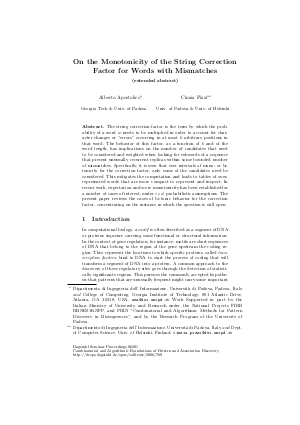On the Monotonicity of the String Correction Factor for Words with Mismatches
Authors Alberto Apostolico, Cinzia Pizzi
-
Part of:
Volume:
Dagstuhl Seminar Proceedings, Volume 6201
Part of: Series: Dagstuhl Seminar Proceedings (DagSemProc) - License:
 Creative Commons Attribution 4.0 International license
Creative Commons Attribution 4.0 International license
- Publication Date: 2006-11-07
File

PDF
DagSemProc.06201.5.pdf
- Filesize: 169 kB
- 9 pages
Document Identifiers
Subject Classification
Keywords
- Pattern discovery
- Motif
- Over-represented word
- Monotone score
- Correction Factor
Metrics
- Access Statistics
-
Total Accesses (updated on a weekly basis)
0PDF Downloads0Metadata Views
Abstract
The string correction factor is the term by
which the probability of a word $w$ needs to be multiplied in order
to account for character changes or ``errors'' occurring in at most
$k$ arbitrary positions in that word. The behavior of this factor,
as a function of $k$ and of the word length, has implications on the
number of candidates that need to be considered and weighted when
looking for subwords of a sequence that present unusually recurrent
replicas within some bounded number of mismatches. Specifically, it
is seen that over intervals of mono- or bi-tonicity for the
correction factor, only some of the candidates need be considered.
This mitigates the computation and leads to tables of
over-represented words that are more compact to represent and
inspect. In recent work, expectation and score monotonicity has been
established for a number of cases of interest, under {em i.i.d.}
probabilistic assumptions. The present paper reviews the cases of
bi-tonic behavior for the correction factor, concentrating on the
instance in which the question is still open.
Cite As Get BibTex
Alberto Apostolico and Cinzia Pizzi. On the Monotonicity of the String Correction Factor for Words with Mismatches. In Combinatorial and Algorithmic Foundations of Pattern and Association Discovery. Dagstuhl Seminar Proceedings, Volume 6201, pp. 1-9, Schloss Dagstuhl – Leibniz-Zentrum für Informatik (2006)
https://doi.org/10.4230/DagSemProc.06201.5
BibTex
@InProceedings{apostolico_et_al:DagSemProc.06201.5,
author = {Apostolico, Alberto and Pizzi, Cinzia},
title = {{On the Monotonicity of the String Correction Factor for Words with Mismatches}},
booktitle = {Combinatorial and Algorithmic Foundations of Pattern and Association Discovery},
pages = {1--9},
series = {Dagstuhl Seminar Proceedings (DagSemProc)},
ISSN = {1862-4405},
year = {2006},
volume = {6201},
editor = {Rudolf Ahlswede and Alberto Apostolico and Vladimir I. Levenshtein},
publisher = {Schloss Dagstuhl -- Leibniz-Zentrum f{\"u}r Informatik},
address = {Dagstuhl, Germany},
URL = {https://drops.dagstuhl.de/entities/document/10.4230/DagSemProc.06201.5},
URN = {urn:nbn:de:0030-drops-7899},
doi = {10.4230/DagSemProc.06201.5},
annote = {Keywords: Pattern discovery, Motif, Over-represented word, Monotone score, Correction Factor}
}
